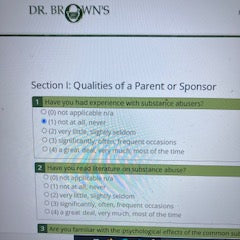8 Panel Home Drug Testing System
Buy Reliable and Easy to Use Anonymous Urine Drug Testing Kit!
Tests for 8 of the most common drugs by CLIA waived lab. Send your samples via mail and receive confidential results online.

Dr Brown's Home Drug Testing System
4. Signs and Symptoms Scale
4. Signs and Symptoms Scale
Couldn't load pickup availability
It cannot be overemphasized that of all the possible methods for determining whether someone is using drugs (e.g. urine screens, hair testing, ion-spectrometer analysis for trace particles), none is more important than knowing the subject. This is true for parents of children and the relatives of post-addicts in recovery. Knowing the unique and subtle habits of the individual is of great importance in accurately evaluating their behavior to determine whether it indicates involvement with drugs.
Unfortunately, drug abuse has become an intrinsic part of our culture.
Knowing the person helps to give the proper weight and perspective to behavior that might otherwise be incriminating or appear to be normal. The truth is that although there are some objective signs and symptoms, even the most accurate evaluation of them is determined by the extent of personal knowledge of the individual. For example, a positive urine screen may reflect that the individual in question is drug-dependent, a weekend user, or a first-time experimenter. The person may have started using drugs to lose weight, to be accepted by friends, to control pain from cancer, or to soothe a burn injury. Post-addicts in particular are usually grand masters of denial and rationalizing their behavior. If you are not, or do not become familiar with them and their history quickly, a lifetime of their using drugs will take place right in front of you, without you realizing it. Unlike signs, symptoms of drug abuse, in most instances, are more obvious and will usually demand immediate attention.
For example:
- being unconscious
- having convulsions
- vomiting
- speaking incoherently
- dizziness
- headaches
- behaving violently
- shaking
- crying
Unfortunately, drug abuse has become an intrinsic part of our culture. Partly as a result of drug abuse by previous generations, there has been a general breakdown of parental responsibility and the instilling of social values and standards of conduct which have in the past distinguished drug abusers from non-drug abusers. There, many of the behaviors that at one time were primarily attributed to drug abuse are being exhibited although the person is not using any drugs. Most noteworthy are incidents of unprovoked violence, child abuse. children cursing and physically attacking their parents, young boys becoming fathers, and girls becoming mothers before they are in their teens. Consequently, not only must you know the individual, but you must also understand the events of the times in order to accurately read the obvious signs pertaining to substance abuse. In their book, How to Keep the Children You Love Off Drugs, Barine and Basch outline some of the obvious items and indicators of drug abuse:
- cigarette rolling papers
- small brown envelopes
- plastic bags
- broken needles
- syringes
- spoons with the tops or bottoms burnt
- smaller/miniature spoons used for sniffing ashes
- hash screens
- bottle caps
- razor blades
- eye droppers
- blood blotched cotton pieces
- lighters
- burnt match sticks
- rubber rope or string used as tourniquets
- smell of rubbing alcohol
- burnt holes in clothes
- burnt holes in furniture
- smell of incense
- deodorizer
- small hard seeds
- ashes
- white powder residue
- significant amount of cash
- new clothes and other items like radio or stereo
- withdrawn behavior
- extended time in bathroom or basement
- loss of longtime friends
- acquisition of new friends
- hanging out without saying where or with whom
To the lay person, it may seem that there are an infinite number of signs and symptoms to interpret. It may be difficult to know where to start. This chart organizes the most significant signs and symptoms to help guide your interpretation of potentially drug-related behavior.
FRAMEWORK FOR THE SIGNS AND SYMPTOMS SCALE
This scale is designed to help the layperson become familiar with and identify signs and symptoms of drug abuse, and measure the extent to which they are being displayed. The scale is designed to evaluate the individual, the head of the household, and the home environment. The scale does not claim to be absolute. It suggests and guides the sponsor of the program to notice some of the more significant indicators of drug abuse. Therefore, if you know nothing about substance abuse, after using the scale you should be sensitive to the more obvious warnings of substance abuse signs and symptoms. The scale and items selected are designed for use by the head of household and other family members. It relies more on observations and opinions developed over time than upon spontaneous impressions or the subject's self-report. The ideal use of the scale would be to evaluate the subject before starting the home drug testing, and then every six months to assess any changes. However, the scale can be used at any time, for anyone, to provide useful measurement of observations about substance abuse. If the subject has just been discharged from treatment or jail, you may wish to wait a few days or a week to make sure your observations are more accurate and consistent with the subject's post-treatment behavior.
Significant ratings on the scale should be viewed as a serious indication of a tendency to be involved in drugs and, along with drug testing results, as another measure of the subject's possible abuse of drugs.
As time progresses, we will be modifying the scale to make it as relevant and efficient as possible. Accordingly, any feedback you provide, will be greatly appreciated.
Share


